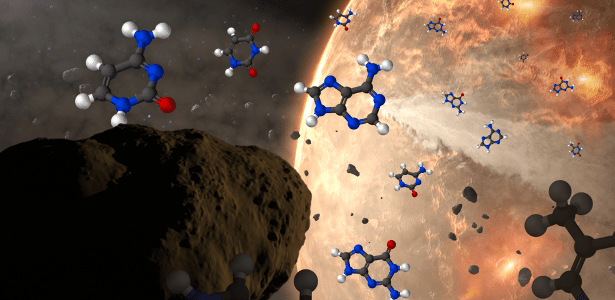Did life come from space? Three meteorites contain all DNA bases
3 min read

Scientists have found, in three meteorites that have fallen to Earth in recent decades, the entire molecular basis of DNA and RNA – the recipe for life.
This new discovery supports the theory that about 4 billion years ago, it was space rocks and cosmic dust that brought the necessary ingredients for the emergence of living things on Earth.
However, it is still not possible to say with certainty that all existing materials are of extraterrestrial origin. Some may have pierced rocks after hitting the ground. Additional studies will attempt to rule out this possibility.
Researchers have analyzed three famous meteorites: Murchison, which fell in Australia in 1969; Murray in the US 1950; and Tagish Lake, Canada in 2000. They are of a rare type called carbonaceous chondrites, which contain many organic compounds and date back to the early days of the solar system.
In them, traces of the five nitrogenous bases of life (the famous “letters”) were found: adenine (A), cytosine (C), guanine (G), thymine (T; present only in DNA) and uracil (U; in RNA).
Three of these substances (A, G, and U) have been found in meteorites before, but cytosine and thymine haven’t appeared in extraterrestrial objects – until now. “In particular, the discovery of cytosine is surprising because it is relatively unstable and tends to react with water,” said Yasuhiro Ohba, a professor at Hokkaido University in Japan and lead author of the study.
To analyze the rocks, the scientists turned to high-performance liquid chromatography (CLEA or HPLC), which uses pressurized water to separate components from meteorite samples. The nitrogenous bases were then extracted and analyzed by mass spectrometry, which revealed the detailed chemical composition of the materials.
To verify that the material was indeed extraterrestrial, the team made sure there was no contamination in the lab and equipment, and also analyzed samples from the site where the Murchison meteorite fell. Some bases have been found in soil, but “their distribution, concentrations, and isomers are distinctly different from those found in meteorites,” Oba said.
The authors concluded that the components formed in space and “contributed to the emergence of the genetic characteristics of the oldest life on Earth.” The study was published this week inNature Communications Magazine.
The origin of life on Earth is one of humanity’s greatest mysteries. This phenomenon could be caused by the internal geochemical processes of our planet, or as some believe, it could have had a small boost from outer space. The Earth underwent a period of intense bombardment of loosened rocks in its “youth”.
But even assuming that all the basic materials did indeed originate in space, it’s hard to say what concentration of DNA bases meteorites would have to contain, or how many meteorites might collide with us, to actually cause life.
In the future, Oba and his team plan to look for nitrogenous bases in material collected directly from asteroids — not from meteorites that have fallen to Earth. This reduces the concern of pollutants.
This may not be so far-fetched. Recently, the Japanese probe Hayabusa2 returned fragments of Ryugu asteroid; And NASA’s OSIRIS-REx must arrive with a cut from beno in 2023.

“Musicaholic. Thinker. Extreme travel trailblazer. Communicator. Total creator. Twitter enthusiast.”





